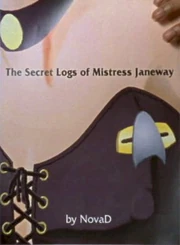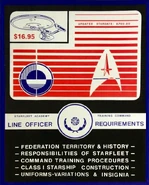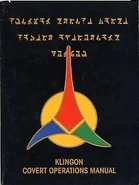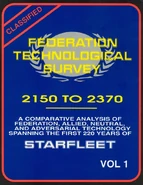m (-interpretation. stick to the facts.) |
m (Robot: Automated text replacement (-''Star Trek'' films +{{Star Trek films}})) |
||
| (11 intermediate revisions by 10 users not shown) | |||
| Line 1: | Line 1: | ||
| − | {{realworld}} |
+ | {{realworld}}__NOTOC__ |
[[File:The Secret Logs of Mistress Janeway.jpg|thumb|''The Secret Logs of Mistress Janeway'']] |
[[File:The Secret Logs of Mistress Janeway.jpg|thumb|''The Secret Logs of Mistress Janeway'']] |
||
<!-- Please note: this is not a page to promote your own fan fiction. --> |
<!-- Please note: this is not a page to promote your own fan fiction. --> |
||
'''Fan fiction''' is a name given to any fictional story or material based in and around the ''[[Star Trek]]'' universe, that is not produced with the input of the creators or licensees who create new ''Star Trek'' material for [[Paramount Pictures]]. Although the most common form is in prose, similar to the various [[novels]], it can also come under the form of scripts, poetry, reference material, games, audio recordings, and films. |
'''Fan fiction''' is a name given to any fictional story or material based in and around the ''[[Star Trek]]'' universe, that is not produced with the input of the creators or licensees who create new ''Star Trek'' material for [[Paramount Pictures]]. Although the most common form is in prose, similar to the various [[novels]], it can also come under the form of scripts, poetry, reference material, games, audio recordings, and films. |
||
| − | It is illegal to buy or sell "fan-produced" memorabilia for profit, due to the {{ma|copyrights}} of the name ''Star Trek'', in addition to the copyrights of the major names involved, being owned by Paramount. Despite this, some fans take it upon themselves to create their own versions of ''Trek'' on a "not-for-profit" basis. |
+ | It is illegal to buy or sell "[[Trekkie|fan]]-produced" memorabilia for profit, due to the {{ma|copyrights}} of the name ''Star Trek'', in addition to the copyrights of the major names involved, being owned by Paramount. Despite this, some fans take it upon themselves to create their own versions of ''Trek'' on a "not-for-profit" basis. |
| ⚫ | |||
| + | |||
| + | == Fanzines == |
||
In the early days of fan fiction, the easiest way for fans to read, and circulate, their works was through fanzine or folios. Some of these fan productions were even used in ''Star Trek'' productions, such as pages of fan-published reference manuals being used on screen as background artwork, and some were created by authors who went on to work on legitimate ''Star Trek'' productions. Paramount has even supported the professional publication of fan fiction through their ''[[The New Voyages]]'', ''[[The New Voyages 2]]'', and ''[[Star Trek: Strange New Worlds|Strange New Worlds]]'' series of books. |
In the early days of fan fiction, the easiest way for fans to read, and circulate, their works was through fanzine or folios. Some of these fan productions were even used in ''Star Trek'' productions, such as pages of fan-published reference manuals being used on screen as background artwork, and some were created by authors who went on to work on legitimate ''Star Trek'' productions. Paramount has even supported the professional publication of fan fiction through their ''[[The New Voyages]]'', ''[[The New Voyages 2]]'', and ''[[Star Trek: Strange New Worlds|Strange New Worlds]]'' series of books. |
||
| − | [[Franz Joseph]] was one of the first to publish fan reference material |
+ | [[Franz Joseph]] was one of the first to publish fan reference material starting in 1973 when he created and published his blueprints ''Booklet of General Plans – USS ''Constitution''-class'' for the {{USS|Enterprise|NCC-1701}}. His blueprints were used in a number of the early {{Star Trek films}}. Other creators that began with fan publications include [[Rick Sternbach]], an illustrator for {{film|1}} and the spin-off series, and [[Geoffrey Mandel]], a scenic artist on ''[[Star Trek: Voyager]]'', ''[[Star Trek: Enterprise]]'', and {{film|9}}. |
| ⚫ | |||
| ⚫ | One of the more recent phenomena in fan fiction is the fan film. These films vary in length from short clips to full episodes, some even comprising of several seasons of episodes. In the past, production technology and cost were major limitations to amateur projects, but in modern times, films can be distributed cheaply via the Internet, and convincing visual effects can be created using home computers. Some of these productions are popular enough to have some [[production staff]] lend their support. |
||
| ⚫ | The friendship between [[James T. Kirk|Kirk]] and [[Spock]] created a subculture of ''Star Trek'' fans who believed the relationship between the two to be not merely platonic, but explicitly romantic – in 1974, the short story "A Fragment out of Time" by author Diane Marchant was the first explicitly sexual fanfiction piece featuring two men to be published in a fanzine, although they were not mentioned by name. In the next edition of that fanzine, Marchant confirmed that the two men were Kirk and Spock and wrote an essay defending the pairing. |
||
| ⚫ | Gene Roddenberry's [[Star Trek: The Motion Picture (novel)|novelization]] of {{film|1}} revealed that Spock thought of Kirk as his "t'hy'la", a Vulcan word meaning "friend/brother/lover." When asked about this possibility, the actors and Roddenberry neither confirmed nor denied this interpretation. Gene Roddenberry, when interviewed for the authorized [[William Shatner]] biography ''[[Shatner: Where No Man...]]'', was asked about comparisons between Kirk and Spock and the historical relationship of Alexander the Great and Hephaestion, two men widely believed to have been lovers. Roddenberry replied, "''Yes, there's certainly some of that – certainly with love overtones. Deep love. The only difference being, the Greek ideal – we never suggested in the series – physical love between the two. But it's the – we certainly had the feeling that the affection was sufficient for that, if that were the particular style of the 23rd century.''" |
||
| ⚫ | Some fan produced games have joined into licensing agreements with Paramount including ''[[Star Trek: A Call to Duty]]'' and the ''Star Trek Simulation Forum''. The ''Simulation Forum'' was created in 2002 as the official chat based role-playing game of [[StarTrek.com]], but had lost its official affiliation by late 2007. |
||
| ⚫ | |||
| ⚫ | |||
| + | == Fan films and games == |
||
| ⚫ | |||
| ⚫ | One of the more recent phenomena in fan fiction is the fan film. These films vary in length from short clips to full episodes, some even comprising of several seasons of episodes. In the past, production technology and cost were major limitations to amateur projects, but in modern times, films can be distributed cheaply via the Internet, and convincing visual effects can be created using home computers. Some of these productions are popular enough to have some [[production staff]] lend their support. |
||
| ⚫ | Some fan produced games have joined into licensing agreements with Paramount including ''[[Star Trek: A Call to Duty]]'' and the ''Star Trek Simulation Forum''. The ''Simulation Forum'' was created in 2002 as the official chat based role-playing game of [[StarTrek.com]], but had lost its official affiliation by late 2007. |
||
| ⚫ | |||
| ⚫ | The friendship between [[James T. Kirk|Kirk]] and [[Spock]] created a subculture of ''Star Trek'' fans who believed the relationship between the two to be not merely platonic, but explicitly romantic – in 1974, the short story "A Fragment out of Time" by author Diane Marchant was the first explicitly sexual fanfiction piece featuring two men to be published in a fanzine, although they were not mentioned by name. In the next edition of that fanzine, Marchant confirmed that the two men were Kirk and Spock and wrote an essay defending the pairing. |
||
| ⚫ | |||
| ⚫ | Gene Roddenberry's [[Star Trek: The Motion Picture (novel)|novelization]] of {{film|1}} revealed that Spock thought of Kirk as his "t'hy'la", a Vulcan word meaning "friend/brother/lover." When asked about this possibility, the actors and Roddenberry neither confirmed nor denied this interpretation. Gene Roddenberry, when interviewed for the authorized [[William Shatner]] biography ''[[Shatner: Where No Man...]]'', was asked about comparisons between Kirk and Spock and the historical relationship of Alexander the Great and Hephaestion, two men widely believed to have been lovers. Roddenberry replied, "''Yes, there's certainly some of that – certainly with love overtones. Deep love. The only difference being, the Greek ideal – we never suggested in the series – physical love between the two. But it's the – we certainly had the feeling that the affection was sufficient for that, if that were the particular style of the 23rd century.''" |
||
| ⚫ | |||
<gallery> |
<gallery> |
||
| − | File:Doctor and Enterprise.jpg|''The Doctor and the Enterprise'', a 1989 publication by [[Movie Publisher Services]] crossing ''Star Trek'' with ''Doctor Who'' and the ''Wizard of Oz'' |
+ | File:Doctor and Enterprise.jpg|''The Doctor and the Enterprise'', a 1989 publication by [[Movie Publisher Services]] crossing ''Star Trek'' with ''[[Doctor Who]]'' and the ''Wizard of Oz'' |
File:StarWreck1Cover.jpg|The first ''Star Wreck'' parody novel published by St. Martin's Paperbacks |
File:StarWreck1Cover.jpg|The first ''Star Wreck'' parody novel published by St. Martin's Paperbacks |
||
| − | File:Starfleet Academy Training Command Line Officer Requirements.jpg|''Starfleet Academy Training Command: Line Officer Requirements''<br>by David John Schmidt |
+ | File:Starfleet Academy Training Command Line Officer Requirements.jpg|''Starfleet Academy Training Command: Line Officer Requirements''<br />by David John Schmidt |
| − | File:Klingon Covert Operations Manual.jpg|''Klingon Covert Operations Manual''<br>by David Christensen and Cathy Doser |
+ | File:Klingon Covert Operations Manual.jpg|''Klingon Covert Operations Manual''<br />by David Christensen and Cathy Doser |
| − | File:Enterprise Officer's Manual.jpg|''USS ''Enterprise'' Officer's Manual''<br>by [[Geoffrey Mandel]] and [[Doug Drexler]] |
+ | File:Enterprise Officer's Manual.jpg|''USS ''Enterprise'' Officer's Manual''<br />by [[Geoffrey Mandel]] and [[Doug Drexler]] |
| − | File:Federation Technological Survey.jpg|''Federation Technological Survey''<br>by Lawrence Miller |
+ | File:Federation Technological Survey.jpg|''Federation Technological Survey''<br />by Lawrence Miller |
</gallery> |
</gallery> |
||
== External links == |
== External links == |
||
| − | * |
+ | *[[w:c:stexpanded|''Star Trek'' Expanded Universe]] - a wiki created to collect information about and from various fan-made projects, including RPGs, fan fiction and fan movies |
| − | * |
+ | *{{Wikipedia|Fan fiction}} |
| − | * |
+ | *{{Wikipedia|Slash fiction}} |
| − | * |
+ | *{{Wikipedia|Fan film}} |
| − | [[de:Fan- |
+ | [[de:Fan-Projekte]] |
[[es:Fan Film]] |
[[es:Fan Film]] |
||
[[fr:Fanfilm]] |
[[fr:Fanfilm]] |
||
| − | [[Category:Star Trek]] |
+ | [[Category:Star Trek and pop culture]] |
Revision as of 17:59, 28 July 2013
Template:Realworld

The Secret Logs of Mistress Janeway
Fan fiction is a name given to any fictional story or material based in and around the Star Trek universe, that is not produced with the input of the creators or licensees who create new Star Trek material for Paramount Pictures. Although the most common form is in prose, similar to the various novels, it can also come under the form of scripts, poetry, reference material, games, audio recordings, and films.
It is illegal to buy or sell "fan-produced" memorabilia for profit, due to the copyrights of the name Star Trek, in addition to the copyrights of the major names involved, being owned by Paramount. Despite this, some fans take it upon themselves to create their own versions of Trek on a "not-for-profit" basis.
A related concept is "fanon", a contraction for "fan canon". Fanon is a belief held by fans that is not canon. Fanon can range from discounting part of Star Trek as non-canon to making up a explanation for unexplained inconsistencies such as the differing appearance of the Trill.
Fanzines
In the early days of fan fiction, the easiest way for fans to read, and circulate, their works was through fanzine or folios. Some of these fan productions were even used in Star Trek productions, such as pages of fan-published reference manuals being used on screen as background artwork, and some were created by authors who went on to work on legitimate Star Trek productions. Paramount has even supported the professional publication of fan fiction through their The New Voyages, The New Voyages 2, and Strange New Worlds series of books.
Franz Joseph was one of the first to publish fan reference material starting in 1973 when he created and published his blueprints Booklet of General Plans – USS Constitution-class for the USS Enterprise. His blueprints were used in a number of the early Star Trek films. Other creators that began with fan publications include Rick Sternbach, an illustrator for Star Trek: The Motion Picture and the spin-off series, and Geoffrey Mandel, a scenic artist on Star Trek: Voyager, Star Trek: Enterprise, and Star Trek: Insurrection.
Kirk, Spock and the creation of Slash
The friendship between Kirk and Spock created a subculture of Star Trek fans who believed the relationship between the two to be not merely platonic, but explicitly romantic – in 1974, the short story "A Fragment out of Time" by author Diane Marchant was the first explicitly sexual fanfiction piece featuring two men to be published in a fanzine, although they were not mentioned by name. In the next edition of that fanzine, Marchant confirmed that the two men were Kirk and Spock and wrote an essay defending the pairing.
Gene Roddenberry's novelization of Star Trek: The Motion Picture revealed that Spock thought of Kirk as his "t'hy'la", a Vulcan word meaning "friend/brother/lover." When asked about this possibility, the actors and Roddenberry neither confirmed nor denied this interpretation. Gene Roddenberry, when interviewed for the authorized William Shatner biography Shatner: Where No Man..., was asked about comparisons between Kirk and Spock and the historical relationship of Alexander the Great and Hephaestion, two men widely believed to have been lovers. Roddenberry replied, "Yes, there's certainly some of that – certainly with love overtones. Deep love. The only difference being, the Greek ideal – we never suggested in the series – physical love between the two. But it's the – we certainly had the feeling that the affection was sufficient for that, if that were the particular style of the 23rd century."
The notion of "slash" as a genre – or the idea that certain relationships between two men or women in popular films, television shows, and literature are subtextually homoerotic – has since spread to fans of other entertainment media.
Fan films and games
One of the more recent phenomena in fan fiction is the fan film. These films vary in length from short clips to full episodes, some even comprising of several seasons of episodes. In the past, production technology and cost were major limitations to amateur projects, but in modern times, films can be distributed cheaply via the Internet, and convincing visual effects can be created using home computers. Some of these productions are popular enough to have some production staff lend their support.
Some fan produced games have joined into licensing agreements with Paramount including Star Trek: A Call to Duty and the Star Trek Simulation Forum. The Simulation Forum was created in 2002 as the official chat based role-playing game of StarTrek.com, but had lost its official affiliation by late 2007.
In the mid-1970s, Star Trek Lives! was published by Bantam Books documenting the fan culture around Star Trek. In the late 1990s, a film, Trekkies was released documenting the fan culture twenty years later.
External links
- Star Trek Expanded Universe - a wiki created to collect information about and from various fan-made projects, including RPGs, fan fiction and fan movies
- Fan fiction at Wikipedia
- Slash fiction at Wikipedia
- Fan film at Wikipedia




